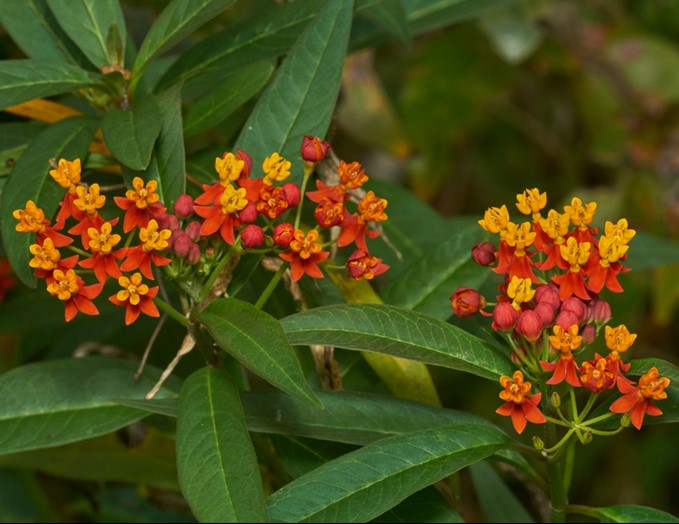Tropical Milkweed
Asclepias curassavica
Note: Tropical milkweed can interfere with monarch migration and reproduction. When grown in areas where it can grow later in the year than native species, the presence of tropical milkweed may confuse monarchs into breeding at a time when they should be migrating. If your TROPICAL milkweed is still blooming during the fall monarch migration, please cut it to the ground to protect the migrating Monarchs.
Characteristics
- Type: Annual
- Zone: 9 – 11
- Height: 2 – 3 Feet
- Spread: 1.5 – 2 Feet
- Bloom Time: June -October
- Blooms: Red-Orange with Yellow Hood
- Sun: Full Sun
- Water: Medium
- Maintenance: Low
- Flower: Showy
- Attracts: Hummingbirds, Butterflies, Bees
- Tolerates: Deer
Culture
Tropical Milkweed grows easily from seed each year. Start seed indoors in pots 8-10 weeks before last spring frost date. Plant seedlings outside after last frost date. Grows best in light, rich, evenly moist, well-drained soil in full sun. Tolerates some light shade and some soil dryness. Also called Mexican milkweed, plants are noted for being weedy in their native tropical habitats and in warm winter areas such as the deep South where they will self-seed somewhat profusely. Container plants may be cut back and brought inside into bright sunny locations in winter. May also be grown as an indoor plant in bright sun with regular watering during the growing season and with reduced watering in a cool location in winter.
Noteworthy Characteristics
Asclepias curassavica is a tender evergreen perennial in the dogbane and milkweed family. It has a much longer flowering period than the perennial milkweeds. It typically grows as a subshrub to 2-3’ tall on upright stems clad with pointed, opposite, lanceolate leaves. Leaves are medium green sometimes with white midribs. Showy flowers with five sepals and five lobes appear in rounded axillary clusters late spring to early summer. Flowers are red-orange with yellow hoods. Flowering continues throughout the summer to early autumn. Hummingbirds, butterflies and bees are attracted to the flowers. Flowers are followed by long, narrow seed pods (3-4” long) which split open when ripe releasing silky tailed seeds for dispersal by wind. Stems and leaves exude a milky sap when cut or bruised. Plants can be poisonous to livestock.
Problems
No serious insect or disease problems. Somewhat weedy and can spread in warm winter locations where it will self-seed. Watch for aphids. Sooty mold may develop if aphid populations are not checked. Consider wearing gloves when working with these plants because the milky sap is poisonous if ingested and can be toxic to human skin.
Garden Uses
Attractive foliage and flowers for beds, borders, cottage gardens, meadows and butterfly gardens. Also a good cut flower. Dried seed pods are attractive in arrangements.
Courtesy of Missouri Botanical Society Plant Finder
